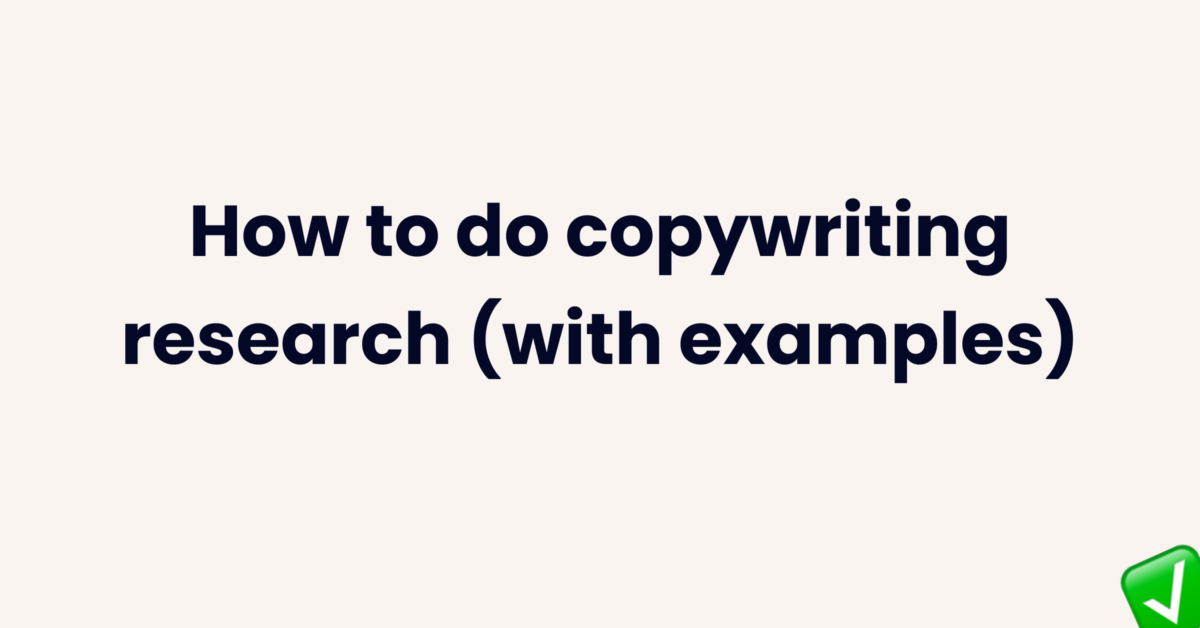How to do copywriting research (with examples)
The more I know about you, the easier it is for me to convince you. Just imagine you’re my friend (Jack/Jessica), and I know you love soccer and snacks.
It’s now easier for me to convince you to join our soccer weekend party.
Your potential customers are no different. The more you know about their pain points, desired wants, roadblocks they’ve encountered, and how they interact with your website, the better. This makes it easier for you to convince them to purchase your product.
We at Ontrack follow a simple research process to better understand our audience. My goal with this article is to describe every step in detail.
First, we should clarify what we want to know about our audience. So here are specific data points that will help you better understand your audience:
- What are their pain points?
- What are their desired outcomes?
- What are their purchase prompts?
- What unique value they’ve experienced with our / competitor’s product
- What are their deal-breaker needs
- What questions do they ask?
- What are their objections?
- What do they see in our product as a risk?
- What analogies they’re using
- What stories they’re sharing around the product
Now comes the big question of how to find answers to these questions. Well, we have three choices:
1. Message mining
2. Survey
3. Talking to customer support or the sales team.
This article will cover the details of message mining while sharing the resources, templates, and how-tos to run surveys and what questions you should ask your customer support and sales support team.
Message mining (the most straightforward method)
I believe that message mining is a straightforward method for getting important information about your audience. It’s prevalent because anyone can use this method. On the other hand, you’ll need to spend money and resources to get insights from your survey and interviews.
Even if you’re brand new to the market and don’t have any customers to survey or interview, message mining helps you get into your customers’ heads.
What is message mining?
As its name suggests, it’s about finding out what customers or the customers of your competitors are talking about. What words or phrases are they using to describe their pain points, desired wants, deal-breaker needs, etc.
How to do message mining?
It’s simple. List down your competitors’ list with their URLs.
Read the reviews on their website. Or you can search [their company name] + review / [their company name] + complaints / [their company name] + comments/forums.

The objective here is to find where their audience discusses pain points, desired wants, and deal-breaker needs.
If the product you are selling is new to the market and has no direct competitors, you should check out the Job-to-be-done type of products.
What are the job-to-be-done products?
Before your product, your audience solves the problem you’re trying to solve with other solutions. These solutions are Job-to-be-done type products.
Imagine no one in the world has created a course about YouTube ads. You are the only person who has created a course on YouTube ads. Meaning you don’t have any direct competition.
But it doesn’t mean your audience is quiet and waiting for your video course. As an alternative, your audience reads books to start and scale their businesses with Youtube ads.

Books are your Job-to-be-done competitor.
We need to find these places where we can explore JTBD competitors and reviews around such products.
JTBD competitors: how do you find them?
On Amazon, Producthunt, eBay, or other sites, search for the problem you’re trying to solve or type in what your product does on their search bar.
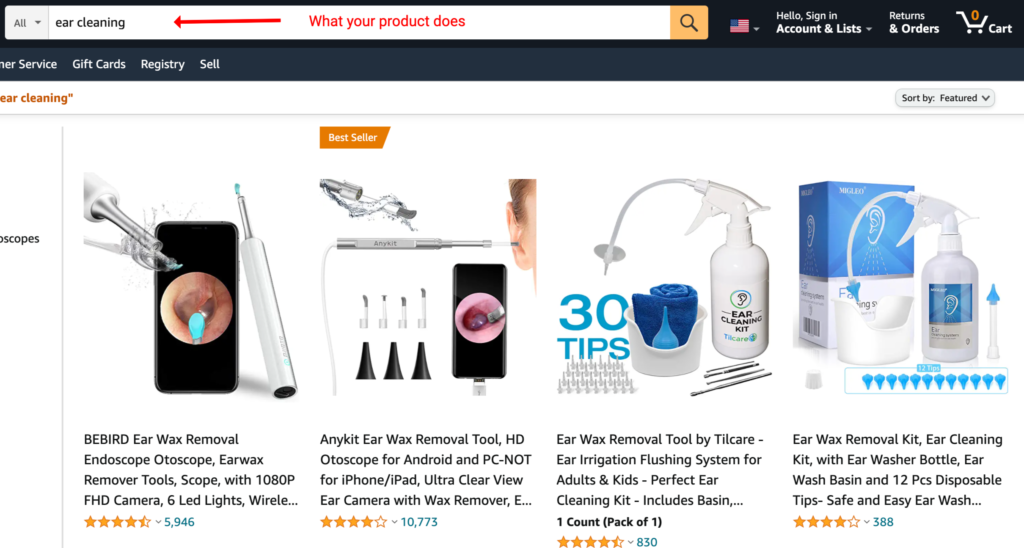
Bam! Now you have a list of brands and products that are not directly competing with you but solve the same problem.
What is UGC?
UGC research is another way to learn how people feel about your product or your competitor’s product. Simply enter your brand’s name, or that of your competitor, in YouTube’s search bar.
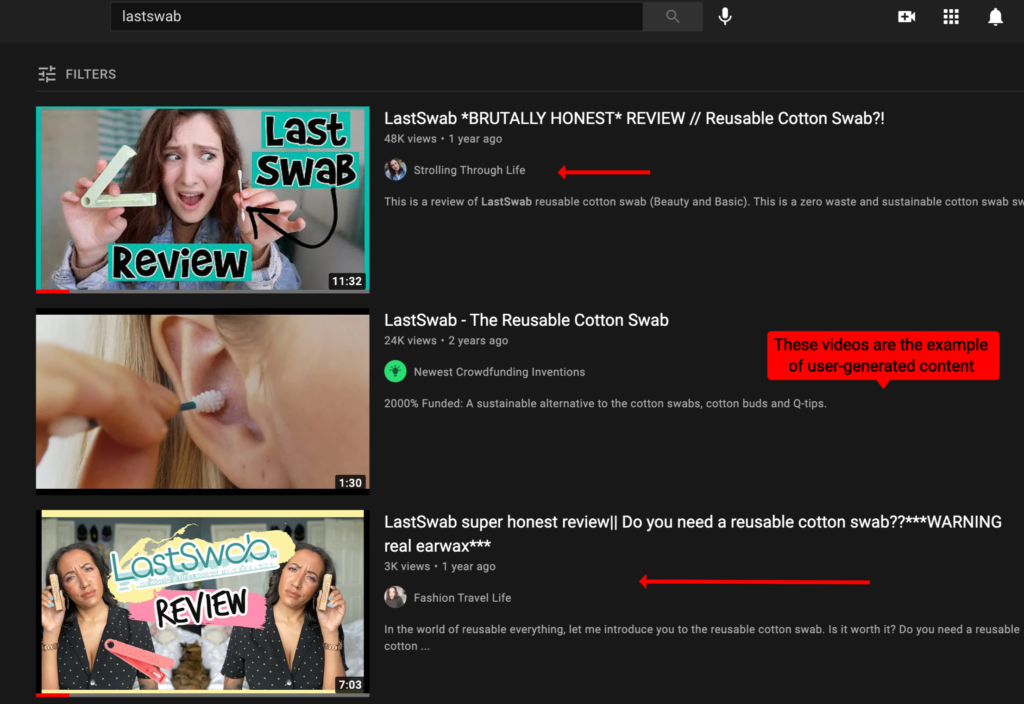
We call this type of content “user-generated content,” where users review products or brands they’ve tried. Look at what people are saying on other social media platforms as well.
So we now have all the resources at our disposal (direct competitors, JTBD products, and user-generated content) from where we can mine reviews and comments to better understand our potential customers. It’s time to start mining.
My first step in the message mining process is to create a Google Doc, where I plan sections for the following pillars or groups.
- Pain points, desired wants, and purchase prompts
- Unique value and deal-breaker needs
- Questions and perceived risk in buying the product
- Key phrases and stories
Let me walk you through how you can do message mining based on these four pillars or groups. Here we go.
Pain points, desired wants, and purchase prompts
This section is where you will aggregate all the comments/reviews or the part of reviews.
To find customer reviews or comments, select a platform. It can be Amazon, Trustpilot, Youtube, your, or your competitors’ websites.
Let’s say you sell ear swabs online. Look for competing products on Amazon. Sort the reviews by five-star rating and start reading them.
In reading, you’ll find reviews like: “that’s why I’ve bought,” or “because I wanted to,” or something that expresses their problems, desired outcomes, and purchase prompts. Simply copy (or say mine) reviews and paste (or say dump) them under this pillar or group.
As a final result, it will look similar to this:
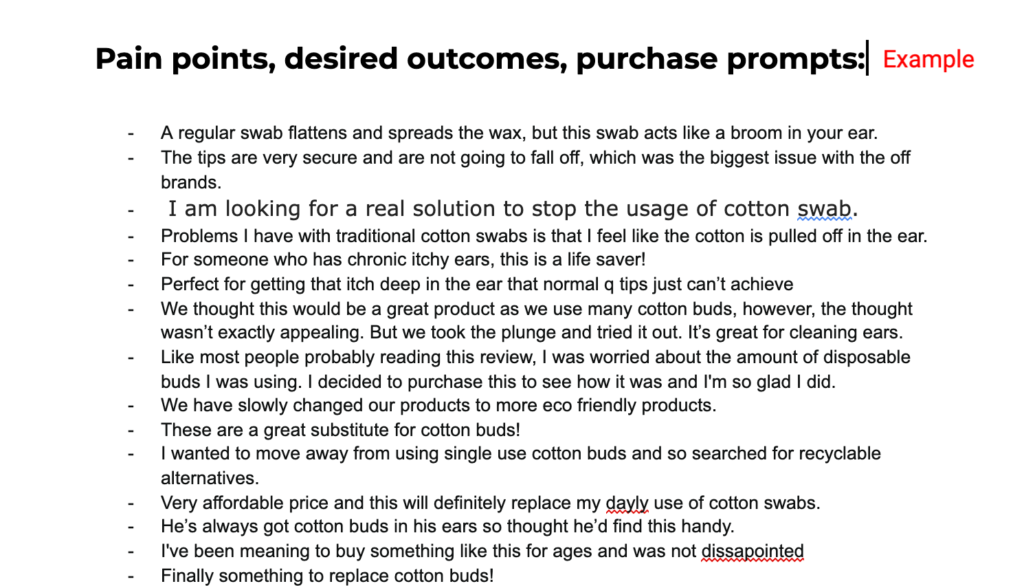
A pro tip: When you read customer reviews, try not to focus only on the pain points or the desired outcome. When reading reviews, try to understand what they are trying to say. Are they expressing their pain points, or are they expressing concerns about perceived risks? Mine and dump their reviews according to the pillar or groups.
Unique value and deal-breaker needs
The same applies to this group. Analyze the reviews of your customers where they express their deal-breaker needs and unique values they’ve experienced with your or your competitor’s product.
In a review, what do unique values and deal-breaker needs look like? If you see people saying “loved” or “easy to clean” something around that line, mine and dump those lines in this group.
As a final result, it will look similar to this:
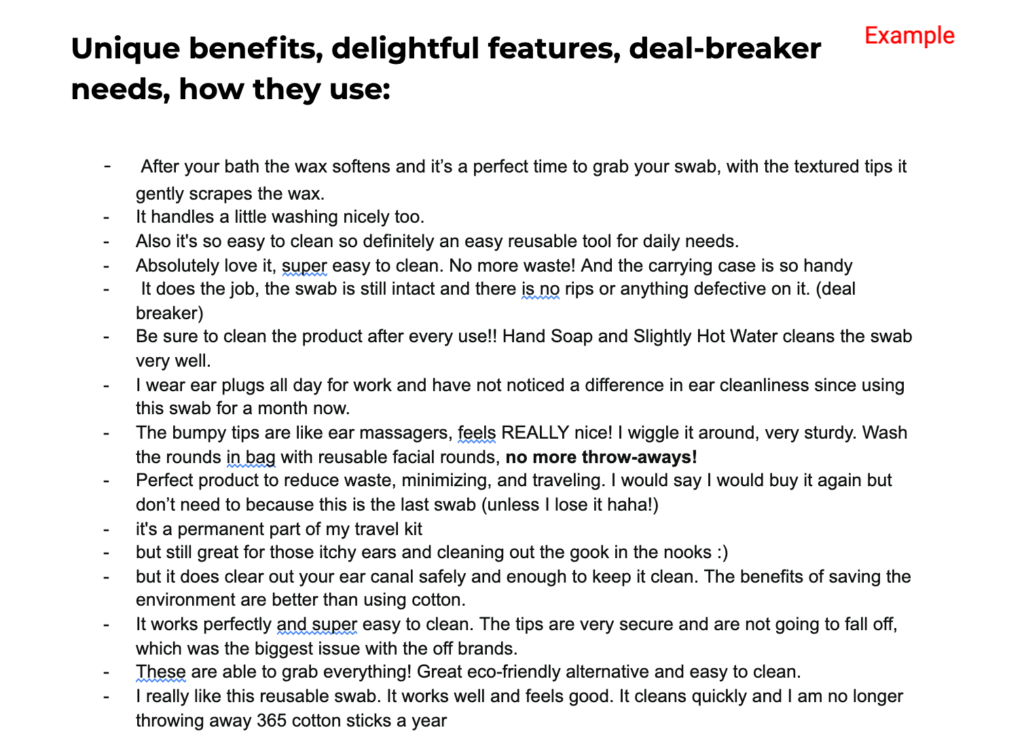
Question and perceived risks
In terms of questions, you’ll find them on Amazon’s “customer questions and answers” section. If you don’t sell on Amazon, read the comments under “user-generated content” to find out what people want to know about your brand or product.
Talking about perceived risks, when people say, “first I was skeptical about…” mine that sentence and dump it here, in this group.
As a final result, it will look similar to this:
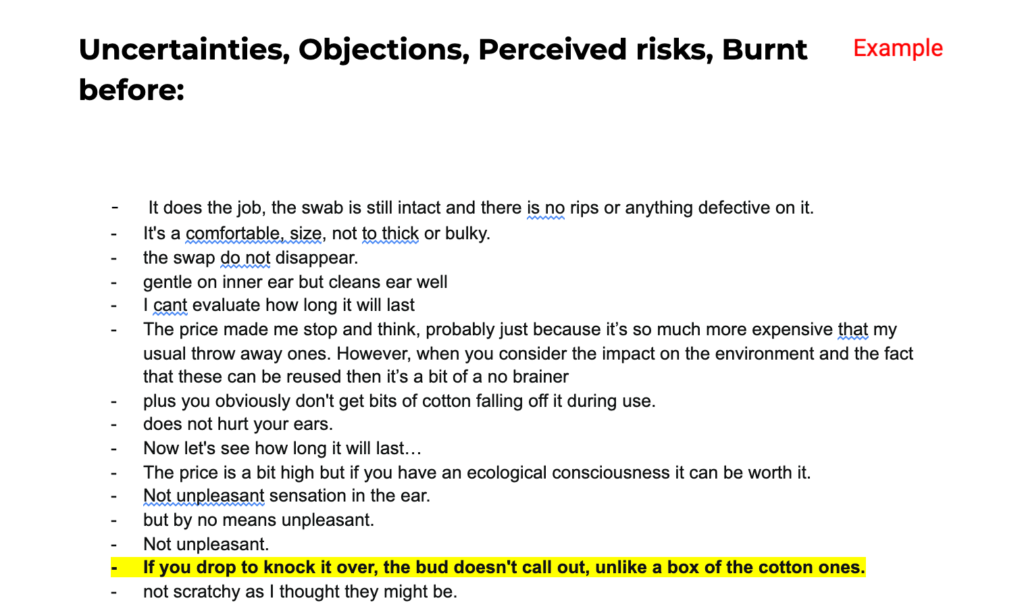
Keyphrases and stories
It is one of my go-to groups for polishing my copy. This is a group where you’ll mine and dump keywords, phrases, and product stories.
Whenever you find people using “helps me rocket past my competitors” or “fun-filled classes for my child,” mine and dump them in this group.
As a final result, it will look similar to this:
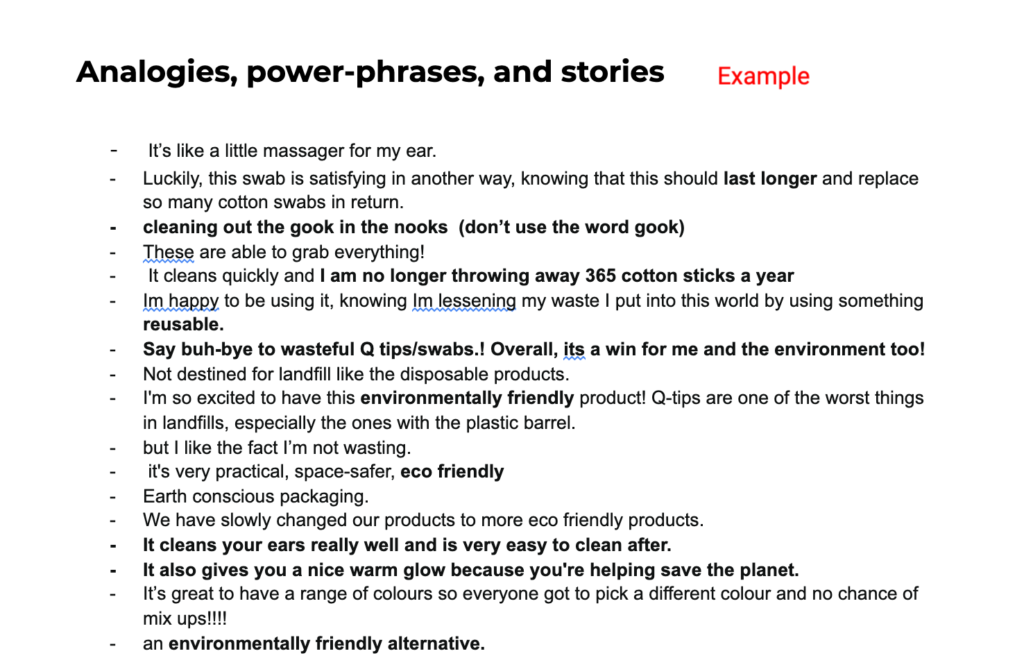
One pro tip: Don’t just mine 3-4 pages of reviews, do as many as you can (minimum of 200 reviews). Also, it’s better to mine reviews from more than one source to learn what your customers like and dislike.
So far, we’ve discussed how to do copywriting research using message mining. However, we should also explore some other ways to conduct copywriting research.
Reading research papers
You should combine this research method with others since it does not provide you with anything you can directly use in your copy. Still, it’s the best method to understand your customers’ psychology.
So, where can you find relevant research papers that relate to your target market?
SCI-HUB and Google scholar are both excellent sources of research papers.
Just go to Google Scholar and search for “why people buy (whatever you sell)” or “motivation to buy (whatever you sell).”
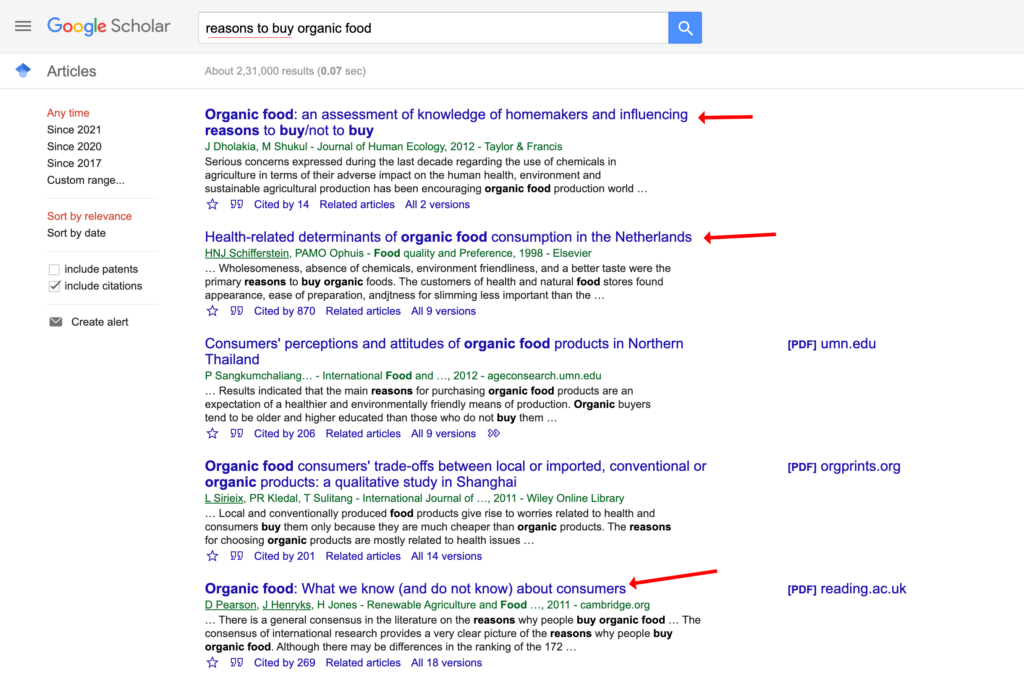
You should read at least three research papers about consumer psychology in your industry.
Survey
Another method of collecting insights about your customers or potential customers.
It is best to use it on top of the messaging mining because you can’t ask website visitors more than one or two questions (because no one likes filling out long surveys).
And when you survey your existing customers, the answers will closely match the insights you’ve gleaned through messaging mining.
So here are some of the topics you should ask your potential customers or website visitors:
- Ask them about their pain points
- Ask them about their purchase prompts
- Ask them about what nearly stops them from buying from you
- Ask them if there is enough information that helps them buy the product
The same is valid for existing customers and first-time customers. Here are some of the topics you should ask your existing customers:
- Ask them about what unique value they’ve experienced
- Ask them about are their desired outcomes
As a pro tip, tell them what you’ll do with their responses and how it will help them improve their overall experience with your brand.
Customer support and sales team
Since your customer support and sales teams are in close contact with your customers every day, they have a better sense of their concerns and desires.
So here are a few questions you might want to ask your customer service or sales team:
- Describe our customers (what’s their profession, interests, and what matters to them)
- What are the biggest challenges, frustration, or problems they express?
- What are the best things you hear about [company] from our customers?
- What are their most asked questions?
- What are your answers to those questions?
If you are a startup or do not have many customers, I recommend that you do message mining and read research papers.
And if you are a brand with hundreds of thousands of customers, you should read research papers, do message mining, and speak to the sales and customer support teams during your copywriting research.
How much research is enough?
The more, the better. However, there is a saturation point. I recommend mining 200+ positive reviews and 100-150 negative reviews when doing message mining.
Why these numbers? When you reach these numbers, you’ll keep hearing the exact wants and pain points over and over.
I’m not telling you to ignore a desire if you hear it twice; otherwise, you’ll lose what matters most to your audience.
If the same desires or pain points appear more than 50 times, it is best to ignore those reviews. It would be better to mention that “this desire or pain point” is important for our audience.
– Reading 4-5 research papers is enough to understand consumer psychology.
– 100 to 200 responses are enough if you’re doing surveys.
– When talking to customer support or the sales team, the more people you talk to, the better.
What to do with all this research?
We started by talking about the better you know your customers, the easier it gets to convince them to buy your product. This research helps you understand what’s important to your customers.
The key to convincing people to buy your product is understanding what’s important to them, answering their questions, and removing barriers.
What does good research look like?
After you have completed your research, you should be able to answer the following questions:
- What problems are most important to my potential customers?
- What are their most desired wants?
- What unique value did they rave about?
- What are the deal-breaker needs of our customers?
- What are their most asked questions?
- What are most people concerned about the product?
Here, you can see that you should always look at what “most people” or “what matters most to them” want. The more data you have, the better.
Conclusion:
To summarize, copywriting research helps to better understand your customers. With a better understanding of them, it will be easier for you to convince them to buy your product. Use your research insights to reinforce motivation, remove barriers, and answer their questions.
